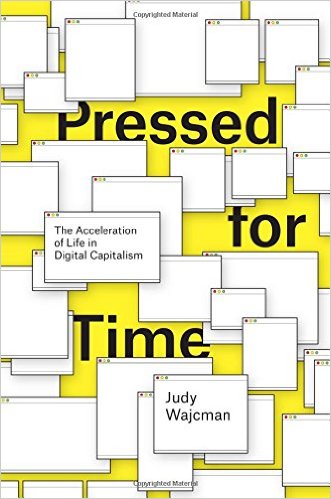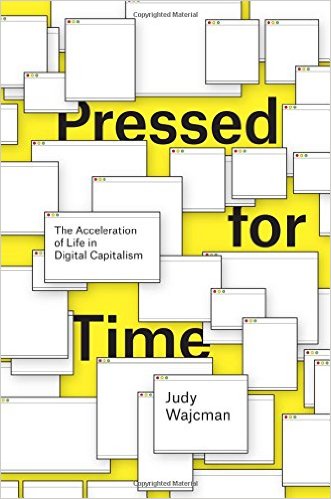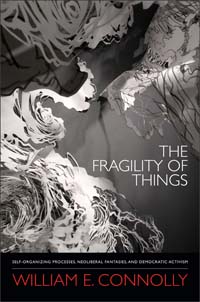 a review of Judy Wajcman, Pressed for Time: The Acceleration of Life in Digital Capitalism (Chicago, 2014)
a review of Judy Wajcman, Pressed for Time: The Acceleration of Life in Digital Capitalism (Chicago, 2014)
by Zachary Loeb
~
Patience seems anachronistic in an age of high speed downloads, same day deliveries, and on-demand assistants who can be summoned by tapping a button. Though some waiting may still occur the amount of time spent in anticipation seems to be constantly diminishing, and every day a new bevy of upgrades and devices promise that tomorrow things will be even faster. Such speed is comforting for those who feel that they do not have a moment to waste. Patience becomes a luxury for which we do not have time, even as the technologies that claimed they would free us wind up weighing us down.
Yet it is far too simplistic to heap the blame for this situation on technology, as such. True, contemporary technologies may be prominent characters in the drama in which we are embroiled, but as Judy Wajcman argues in her book Pressed for Time, we should not approach technology as though it exists separately from the social, economic, and political factors that shape contemporary society. Indeed, to understand technology today it is necessary to recognize that “temporal demands are not inherent to technology. They are built into our devices by all-too-human schemes and desires” (3). In Wajcman’s view, technology is not the true culprit, nor is it an out-of-control menace. It is instead a convenient distraction from the real forces that make it seem as though there is never enough time.
Wajcman sets a course that refuses to uncritically celebrate technology, whilst simultaneously disavowing the damning of modern machines. She prefers to draw upon “a social shaping approach to technology” (4) which emphasizes that the shape technology takes in a society is influenced by many factors. If current technologies leave us feeling exhausted, overwhelmed, and unsatisfied it is to our society we must look for causes and solutions – not to the machine.
The vast array of Internet-connected devices give rise to a sense that everything is happening faster, that things are accelerating, and that compared to previous epochs things are changing faster. This is the kind of seemingly uncontroversial belief that Wajcman seeks to counter. While there is a present predilection for speed, the ideas of speed and acceleration remain murky, which may not be purely accidental when one considers “the extent to which the agenda for discussing the future of technology is set by the promoters of new technological products” (14). Rapid technological and societal shifts may herald the emergence of a “acceleration society” wherein speed increases even as individuals experience a decrease of available time. Though some would describe today’s world (at least in affluent nations) as being a synecdoche of the “acceleration society,” it would be a mistake to believe this to be a wholly new invention.
Nevertheless the instantaneous potential of information technologies may seem to signal a break with the past – as the sort of “timeless time” which “emerged in financial markets…is spreading to every realm” (19). Some may revel in this speed even as others put out somber calls for a slow-down, but either approach risks being reductionist. Wajcman pushes back against the technological determinism lurking in the thoughts of those who revel and those who rebel, noting “that all technologies are inherently social in that they are designed, produced, used and governed by people” (27).
Both today and yesterday “we live our lives surrounded by things, but we tend to think about only some of them as being technologies” (29). The impacts of given technologies depend upon the ways in which they are actually used, and Wajcman emphasizes that people often have a great deal of freedom in altering “the meanings and deployment of technologies” (33).
Over time certain technologies recede into the background, but the history of technology is of a litany of devices that made profound impacts in determining experiences of time and speed. After all, the clock is itself a piece of technology, and thus we assess our very lack of time by looking to a device designed to measure its passage. The measurement of time was a technique used to standardize – and often exploit – labor, and the ability to carefully keep track of time gave rise to an ideology in which time came to be interchangeable with money. As a result speed came to be associated with profit even as slowness became associated with sloth. The speed of change became tied up in notions of improvement and progress, and thus “the speed of change becomes a self-evident good” (44). The speed promised by inventions are therefore seen as part of the march of progress, though a certain irony emerges as widespread speed leads to new forms of slowness – the mass diffusion of cars leading to traffic jams, And what was fast yesterday is often deemed slow today. As Wajcman shows, the experience of time compression that occurs tied to “our valorization of a busy lifestyle, as well as our profound ambivalence toward it” (58), has roots that go far back.
Time takes on an odd quality – to have it is a luxury, even as constant busyness becomes a sign of status. A certain dissonance emerges wherein individuals feel that they have less time even as studies show that people are not necessarily working more hours. For Wajcman much of the explanation is related to “real increases in the combined work commitments of family members as it is about changes in the working time of individuals” with such “time poverty” being experienced particularly acutely “among working mothers, who juggle work, family, and leisure” (66). To understand time pressure it is essential to consider the degree to which people are free to use their time as they see fit.
Societal pressures on the time of men and women differ, and though the hours spent doing paid labor may not have shifted dramatically, the hours parents (particularly mothers) spend performing unpaid labor remains high. Furthermore, “despite dramatic improvements in domestic technology, the amount of time spent on household tasks has not actually shown any corresponding dramatic decline” (68). Though household responsibilities can be shared equitably between partners, much of the onus still falls on women. As a busy event-filled life becomes a marker of status for adults so too may they attempt to bestow such busyness on the whole family, but busy parents needing to chaperone and supervise busy children only creates a further crunch on time. As Wajcman notes “perhaps we should be giving as much attention to the intensification of parenting as to the intensification of work” (82).
Yet the story of domestic, unpaid and unrecognized, labor is a particularly strong example of a space wherein the promises of time-saving technological fixes have fallen short. Instead, “devices allegedly designed to save labor time fail to do so, and in some cases actually increase the time needed for the task” (111). The variety of technologies marketed for the household are often advertised as time savers, yet altering household work is not the same as eliminating it – even as certain tasks continually demand a significant investment of real time.
Many of the technologies that have become mainstays of modern households – such as the microwave – were not originally marketed as such, and thus the household represents an important example of the way in which technologies “are both socially constructed and society shaping” (122). Of further significance is the way in which changing labor relations have also lead to shifts in the sphere of domestic work, wherein those who can afford it are able to buy themselves time through purchasing food from restaurants or by employing others for tasks such as child care and cleaning. Though the image of “the home of the future,” courtesy of the Internet of Things, may promise an automated abode, Wajcman highlights that those making and selling such technologies replicate society’s dominant blind spot for the true tasks of domestic labor. Indeed, the Internet of Things tends to “celebrate technology and its transformative power at the expense of home as a lived practice.” (130) Thus, domestic technologies present an important example of the way in which those designing and marketing technologies instill their own biases into the devices they build.
Beyond the household, information communications technologies (ICTs) allow people to carry their office in their pocket as e-mails and messages ping them long after the official work day has ended. However, the idea “of the technologically tethered worker with no control over their own time…fails to convey the complex entanglement of contemporary work practices, working time, and the materiality of technical artifacts” (88). Thus, the problem is not that an individual can receive e-mail when they are off the clock, the problem is the employer’s expectation that this worker should be responding to work related e-mails while off the clock – the issue is not technological, it is societal. Furthermore, Wajcman argues, communications technologies permit workers to better judge whether or not something is particularly time sensitive. Though technology has often been used by employers to control employees, approaching communications technologies from an STS position “casts doubt on the determinist view that ICTs, per se, are driving the intensification of work” (107). Indeed some workers may turn to such devices to help manage this intensification.
Technologies offer many more potentialities than those that are presented in advertisements. Though the ubiquity of communications devices may “mean that more and more of our social relationships are machine-mediated” (138), the focus should be as much on the word “social” as on the word “machine.” Much has been written about the way that individuals use modern technologies and the ways in which they can give rise to families wherein parents and children alike are permanently staring at a screen, but Wajcman argues that these technologies should “be regarded as another node in the flows of affect that create and bind intimacy” (150). It is not that these devices are truly stealing people’s time, but that they are changing the ways in which people spend the time they have – allowing harried individuals to create new forms of being together which “needs to be understood as adding a dimension to temporal experience” (158) which blurs boundaries between work and leisure.
The notion that the pace of life has been accelerated by technological change is a belief that often goes unchallenged; however, Wajcman emphasizes that “major shifts in the nature of work, the composition of families, ideas about parenting, and patterns of consumption have all contributed to our sense that the world is moving faster than hitherto” (164). The experience of acceleration can be intoxicating, and the belief in a culture of improvement wrought by technological change may be a rare glimmer of positivity amidst gloomy news reports. However, “rapid technological change can actually be conservative, maintaining or solidifying existing social arrangements” (180). At moments when so much emphasis is placed upon the speed of technologically sired change the first step may not be to slow-down but to insist that people consider the ways in which these machines have been socially constructed, how they have shaped society – and if we fear that we are speeding towards a catastrophe than it becomes necessary to consider how they can be socially constructed to avoid such a collision.
* * *
It is common, amongst current books assessing the societal impacts of technology, for authors to present themselves as critical while simultaneously wanting to hold to an unshakable faith in technology. This often leaves such texts in an odd position: they want to advance a radical critique but their argument remains loyal to a conservative ideology. With Pressed for Time, Judy Wajcman, has demonstrated how to successfully achieve the balance between technological optimism and pessimism. It is a great feat, and Pressed for Time executes this task skillfully. When Wajcman writes, towards the end of the book, that she wants “to embrace the emancipatory potential of technoscience to create new meanings and new worlds while at the same time being its chief critic” (164) she is not writing of a goal but is affirming what she has achieved with Pressed for Time (a similar success can be attributed to Wajcman’s earlier books TechnoFeminism (Polity, 2004) and the essential Feminism Confronts Technology (Penn State, 1991).
By holding to the framework of the social shaping of technology, Pressed for Time provides an investigation of time and speed that is grounded in a nuanced understanding of technology. It would have been easy for Wajcman to focus strictly on contemporary ICTs, but what her argument makes clear is that to do so would have been to ignore the facts that make contemporary technology understandable. A great success of Pressed for Time is the way in which Wajcman shows that the current sensation of being pressed for time is not a modern invention. Instead, the emphasis on speed as being a hallmark of progress and improvement is a belief that has been at work for decades. Wajcman avoids the stumbling block of technological determinism and carefully points out that falling for such beliefs leads to critiques being directed incorrectly. Written in a thoroughly engaging style, Pressed for Time is an academic book that can serve as an excellent introduction to the terminology and style of STS scholarship.
Throughout Pressed for Time, Wajcman repeatedly notes the ways in which the meanings of technologies transcend what a device may have been narrowly intended to do. For Wajcman people’s agency is paramount as people have the ability to construct meaning for technology even as such devices wind up shaping society. Yet an area in which one could push back against Wajcman’s views would be to ask if communications technologies have shaped society to such an extent that it is becoming increasingly difficult to construct new meanings for them. Perhaps the “slow movement,” which Wajcman describes as unrealistic for “we cannot in fact choose between fast and slow, technology and nature” (176), is best perceived as a manifestation of the sense that much of technology’s “emancipatory potential” has gone awry – that some technologies offer little in the way of liberating potential. After all, the constantly connected individual may always feel rushed – but they may also feel as though they are under constant surveillance, that their every online move is carefully tracked, and that through the rise of wearable technology and the Internet of Things that all of their actions will soon be easily tracked. Wajcman makes an excellent and important point by noting that humans have always lived surrounded by technologies – but the technologies that surrounded an individual in 1952 were not sending every bit of minutiae to large corporations (and governments). Hanging in the background of the discussion of speed are also the questions of planned obsolescence and the mountains of toxic technological trash that wind up flowing from affluent nations to developing ones. The technological speed experienced in one country is the “slow violence” experienced in another. Though to make these critiques is to in no way to seriously diminish Wajcman’s argument, especially as many of these concerns simply speak to the economic and political forces that have shaped today’s technology.
Pressed for Time is a Rosetta stone for decoding life in high speed, high tech societies. Wajcman deftly demonstrates that the problems facing technologically-addled individuals today are not as new as they appear, and that the solutions on offer are similarly not as wildly inventive as they may seem. Through analyzing studies and history, Wajcman shows the impacts of technologies, while making clear why it is still imperative to approach technology with a consideration of class and gender in mind. With Pressed for Time, Wajcman champions the position that the social shaping of technology framework still provides a robust way of understanding technology. As Wajcman makes clear the way technologies “are interpreted and used depends on the tapestry of social relations woven by age, gender, race, class, and other axes of inequality” (183).
It is an extremely timely argument.
_____
Zachary Loeb is a writer, activist, librarian, and terrible accordion player. He earned his MSIS from the University of Texas at Austin, and is currently working towards an MA in the Media, Culture, and Communications department at NYU. His research areas include media refusal and resistance to technology, ethical implications of technology, infrastructure and e-waste, as well as the intersection of library science with the STS field. Using the moniker “The Luddbrarian,” Loeb writes at the blog Librarian Shipwreck and is a frequent contributor to The b2 Review Digital Studies section.

